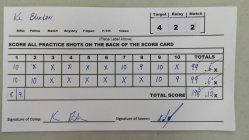Everything you said is essentially correct except for "good" brass life. I initially prepped ~450 pieces from the same lot, so I can't really say yet how many firings it will get. QL predicted pressure is ~57.3K psi and in my hands, if you go much higher than that the primer pockets will go south pretty [very] quickly. I'm guessing that barrel life ought not to be too bad, which is to say maybe 2500-3500 rounds. Could be a little bit more, it's hard to say just yet. As mentioned, I could achieve velocities above 2900 fps with H4895 relatively easily, in other words case capacity is not limiting. However, the predicted pressure was ~59K psi and brass life was pretty much nonexistent. I think where the load is currently, I will likely get at least 4-6 firings on the brass. That may be considered quite low for some, but I'd be perfectly happy there. Based on my [unscientific] barrel life estimate above, that would be fairly close to the end of the barrel. I have another identical barrel already chambered at .169 freebore, but as I mentioned that is really much shorter than it should be, especially with the bullets seated at ~.015 off. I will probably throat out the replacement barrel to somewhere on the high side of .200" freebore. That should go quite a way toward extending brass life as QL predicts it will drop the pressure down to ~ 53-54K psi.
Performance so far has been very good IMO. I have not experienced any major difficulties loading the 90s. The only hiccup really was that I thought I would need to seat them into the lands due to the secant ogive and all, so that is where I started. However, I was pleasantly surprised to find out subsequently that they actually shot better from about .011"-.017" off the lands, so that is where I'm loading them. I believe that this has something to do with the very tight (.2242") freebore cut by the ISSF reamer. When I first used a Stoney Point OAL gauge (Hornady) to measure the distance to the lands, I felt a distinct "stop" as the bullet was initially pushed in. But it was far short of where I knew it should be according to the reamer specs. With a little more pressure, the bullets would then slide in quite a bit further, albeit with some slight resistance until a true "hard" stop was reached. As it turned out, that was the tight freebore. It is so tight, the bullet just doesn't have anywhere else to go but straight into the chamber and may be why they don't mind being jumped in my hands.
You can certainly run the numbers yourself, but at 2850 fps, I roughly estimate the BC of my pointed 90s is .290 (G7), representing about a 3% increase from pointing. My 185 Juggernauts are ~ .292 BC, close enough to practically be the same number, but only moving at ~2750 fps muzzle velocity. On paper (JBM Ballistics), the 90s will shoot inside the 185s by 0.3 MOA in a 10 mph full value wind at 1000 yd (6.7 MOA vs 7.0 MOA). I believe this estimate matches very to my shooting experience with both rifles. As far as the 80-somethings, even at 3000 fps they're over 2 MOA behind (8.8 MOA)...it's really not even close. The BC advantage of the 90 VLDs is simply too great to overcome by increasing velocity of the 80s, at least in terms of velocities that can realistically be achieved.
So how would I characterize the differences? I believe that if you can get the 90s working with good precision in the 2800-2850 fps velocity range, you will be shooting on a very equal or even slightly better basis (in terms of wind deflection) to .308 shooters using most bullets up to the approximate BC range of 185 Juggernauts/Hybrids. The significant lack of recoil might even be a slight additional edge to the .223. You will be at a slight to moderate disadvantage to .308 shooters using 200 or 215 Hybrids in terms of wind deflection. You will have a significant edge in windage over someone using 80 gr .223 bullets. As always, these are merely estimates on paper and relative shooter wind reading ability can always come into play. However, I think the above is a pretty fair assessment of where the ballistic potential of a .223 F-TR gun set up to shoot the 90 VLDs will stack up relative to other commonly used .223 Rem and .308 Win bullets. For me, there is just something special about shooting the little .223 Rem with its minimal recoil at 1000 yds. I could certainly get myself a .308 setup in which to shoot 200 or 215 Hybrids, but right now I'm limited to shooting 185s. So I'm not really giving up anything by shooting the .223.












